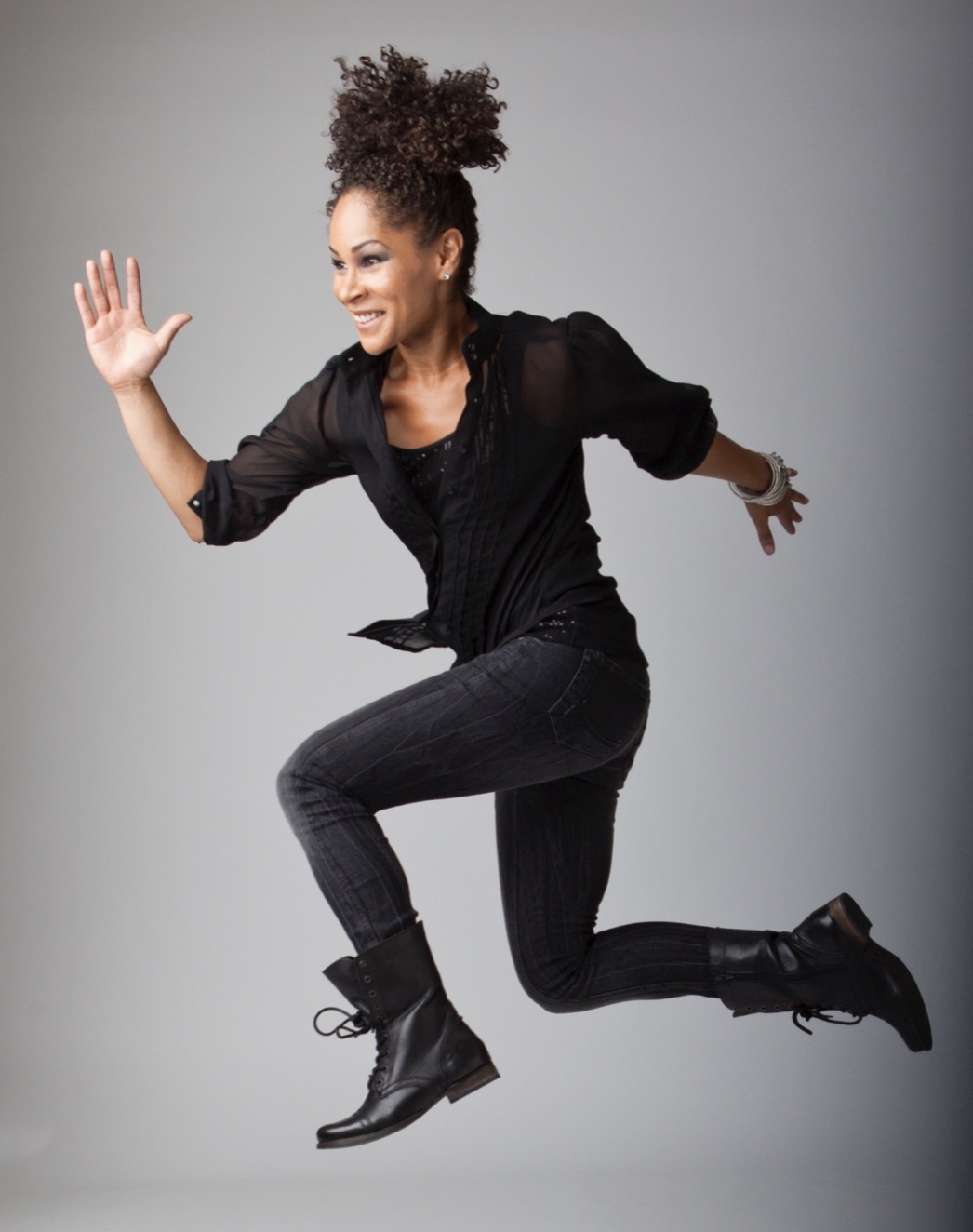In honor of National Tap Dance Day this coming Monday, May 25th, BELatina is revisiting our archives to share this incredible interview we had in 2019 with tap dance extraordinaire Ayodele Casel. Ayodele is teaching a free basic tap class via Operation Tap’s Facebook Live events at 12pm ET on 5/25, and will also be hosting two Q & A sessions throughout the day that explore the themes of purpose and self-expression through dance.
Ayodele Casel graciously squeezed me into a full house for Diálogos: Women of Color in the Arts at New York City’s Ballet Hispánico early in January, where the tap dancer and performer sat with a panel of Latinas for a conversation about their experiences in the arts.
Alongside Ayodele that evening was New York State Senator Marisol Alcántara who spoke passionately about public access to arts and culture in the Dominican-American community of Washington Heights; Lauren Argentina Zelaya, assistant curator of public programs at the Brooklyn Museum, where she runs inclusive and anti-colonial programming for Target First Saturdays; and the influential choreographer, director, and producer Maria Torres who has made it her life’s mission to further her craft while keeping the door open the artists who follow. Tamia Santana who founded the Brooklyn Dance Festival sat in as the moderator of the event.
As a dance form, tap was historically considered “a man’s game” because of its “dance challenge” nature; a tapper on the street or at a social club would dance in response to another tapper’s line, as a sort of challenge or competition — which is something that would not have been at all appropriate for women at the time. Ayodele succeeds today as a tap dancer despite the fact that the form has yet to fully shed its masculine reputation.

She has also worked tirelessly to remind her audiences that tap is deeply rooted in African-American art and culture, though the form has been largely whitewashed through lack of opportunities in film and theater. What we see beginning in the 18th and 19th centuries was a fusion of West African and Irish dance that made its way into minstrel shows, eventually evolving alongside jazz in New York City.
At the panel, I listened as Ayodele and her peers came to an effortless consensus about “putting in the work” no matter the obstacle; it’s not that the work would be easy, but that the work needs to done should go without saying. More importantly, they all agreed that their individual work should also create space for others in their field whom don’t have access to the same opportunity.
It was the first time I had met Ayodele in person since our initial back-and-forth over the holidays, which she had spent with her partner in Puerto Rico. From our conversation, it is clear to me that Puerto Rico is one of two places where her heart resides. As a Bronx-born woman, both black Puerto Rican, who spent the formative years of her youth living on the island, she has been ever immersed in the two intertwined but distinct cultures. These influences shine through her work in the way that she boldly seeks community, the boundlessness of her incandescent passion, and her humility toward the past, present, and future of her craft.
Following the panel, Ayodele and I finally had a chance to catch up via email to discuss her Afro-Latin roots, the challenges she faces as a female tapper, and some of her personal projects.
I loved coming across a clip of a performance you did with Arturo O’ Farrill. There was something so freaking cool about blending tap with Afro-Cuban jazz. What was your relationship with Afro-Latin music before you discovered tap? Especially when you were living in Puerto Rico as a youth, was music a significant part of your life, or was it simply just a given that it was part of your identity?
I am Bronx-born and was raised in Puerto Rico between the ages of 9 and 15 — an extremely formative experience I am so grateful for because I learned that part of my culture firsthand. I learned a new language, an appreciation for nature, and a way of living that is so unique to small town island culture and was introduced to a music and sound that has made an indelible mark on my being and my artistry.
Ironically, when I was young I hated Latin music. Mostly, because I felt my grandfather would play Celia Cruz, El Gran Combo, Hector Lavoe, only to torture me, despite my protests. It was the early ‘80s, I was young, and I wanted to hear Michael Jackson, Cindy Lauper, Madonna, Debbie Gibson… haha. But around my late teens I became completely obsessed with [Latin music]. Dancing and music are such a part of Latin culture. My mom and my aunt would regale me with stories of going to the clubs and getting down! They taught me how to dance, they played it, their joy was infectious. I associate Latin music with great feelings. It’s joyous and I dance and teach to it almost every chance I get.
To get to dance and play with Arturo O’Farrill is a dream. I have such love and respect for the work he does not only with his music but how he thinks and feels as a human being on this earth. When I first danced with him it felt like we had been doing that forever. It was so seamless. So playful, the exchange. We really listen to one another and I’m so thankful for the experience I always want to honor the blessing of being able to do so. We will get many opportunities in this lifetime, I hope.
My understanding is that jazz and tap are closely entwined, and that both are male-dominated fields. Has this presented any particular challenge to you as a female artist who performs in these two worlds?
When I first started tap dancing there were much fewer women who were getting into the ring with the men. I noticed but I was so determined to understand how the dance worked that I didn’t pay it too much mind. I just wanted to dance. I fell in love with it and was going to do it whether there seemed to be a space for me or not. Of course, I’ve been presented with my fair share of sexism — whether by men who seem to want to see women dance a certain way or presenters who feel like men are the hot ticket. I just kept doing my work and continue to. The best answer to any of that is to do your work. There is no competition. Nobody can be me, especially a man. Luckily, we are finally living in a time currently where the voices of women in this art form are being heard and presented. We are being asked to lead and it’s about time.
You had the opportunity to tap at a Broadway fundraiser for Hillary Clinton during her campaign. I imagine you are accustomed to dancing in the context of politics or at least engaging with these issues through performance. What did you most want to bring to the table at this particular performance?
I’d worked with Jeanine Tesori, prolific composer and Michael Mayer, the wonderful theater director on “While I Have The Floor” in the summer of 2016 at New York City Center. Michael was directing the Broadway for Hillary fundraiser and asked if I would perform the piece for the event. I didn’t even hesitate. It has always been my mission to lend my voice to representing women and I felt this platform of supporting a woman in her candidacy for president was an important one.
I felt especially fortunate to be able to have the platform to bring the names and energy of the forgotten African-American women of tap dance to that stage — with so many people watching. I have always been keenly aware of the blessing I’ve received to live my life creatively and primarily as a female tap dancer. I think about the women who looked like me and were representing tap in the twenties-sixties who were up against an era riddled with sexism and racism when nobody fully considered them. They danced as much as they could with class, dignity, and sheer fire and most people don’t know them.
It felt unfair that comparatively, I get to “breeze through” this era as a tap dancer. I can’t change the past but what I can do is bring them with me in all that I do. My successes are theirs. I will speak their names until I can no longer speak: Jeni LeGon, Louise Madison, Cora LaRedd, Juanita Pitts, Lois Bright, Alice Whitman, to name a few. They were holding it down and fighting for representation long before I even thought to put on a tap shoe.
I was never a very good dancer when I used to take class as a child, but during a KonMari purge I recently came across a pair of my aunt’s tap shoes that had been sitting in my closet for over a decade; I remember taking them from her and thinking “I’ll totally use these some day.” Fast forward to December, having never used them before, when I had this fantasy about YouTubing free tap instructional videos to “try it out” without having to commit to a real class. By coincidence, you and some partners have been running a project called Operation Tap which offers exactly what I had been dreaming of. What are your goals for Operation Tap in relation to its audience? Expanding the reach of tap (or dance in general) and making it more egalitarian? Creating alternative dance communities? Experimenting with possibilities for performance.
Operation Tap was founded with the intention of making tap education more accessible to dancers across the country and the world. As tap educators fortunate enough to travel frequently, Anthony Morigerato, Mike Minery, and I often found that in many cities tap education, both in history and in practice, was scarce. A lot of dance teachers and dance students expressed frustration at their lack of access to teachers and found themselves overwhelmed with maintaining the business side of the studio, maintaining the interest to tap among the students, and in many cases, felt they were lacking inspiration because of the limited amount of time they had to dedicate themselves on a personal level to maintaining their own connection and joy with the dance.
We wanted to close a gap, to create a platform where we could provide exercises, post classic clips that inspired us, give teaching tips, and create a forum for the participants to interact with one another and with the content. We’ve created a plethora of free content for users that is up on YouTube and on our social media pages; about three years into our endeavor we began offering a paid subscription with more in depth classes and detailed tutorials. I’m really proud of the way the community engages with us and vice versa.
Do you have a favorite audience to perform for?
My favorite audience is every single person who wants to spend the time with me. I have danced on a subway platform, outside of a subway station, Carnegie Hall, the White House, theater stages, and in my home for all kinds of humans and some pets. Haha. I love that I get to share one of my greatest joys. I still get excited about lacing up my tap shoes. Every single time. It’s like I can’t wait to hear the first sound I make. I love listening and honoring how the dance wants to express itself through me every single time. It is one of the greatest blessings of my life.
You were in Puerto Rico over the holidays. How often do you travel there?
My mom, stepfather, grandmother, and other extended family still live in PR. I try to go a few times a year and have been consistent about that since my return back to New York at the age of 15. I love it. I’m so grateful to have had the Puerto Rican experience and I’m so proud to share that with others. I’ve brought many friends to my hometown. It gives me great joy to be able to show them the beaches, the food, the mountains and hills, the iguanas and lizards, the Flamboyans, my elementary and junior high schools, even the mall I frequented! By the time they leave, I want them to yell “Boricua!!!!”
For Image credit or remove please email for immediate removal - info@belatina.com





































